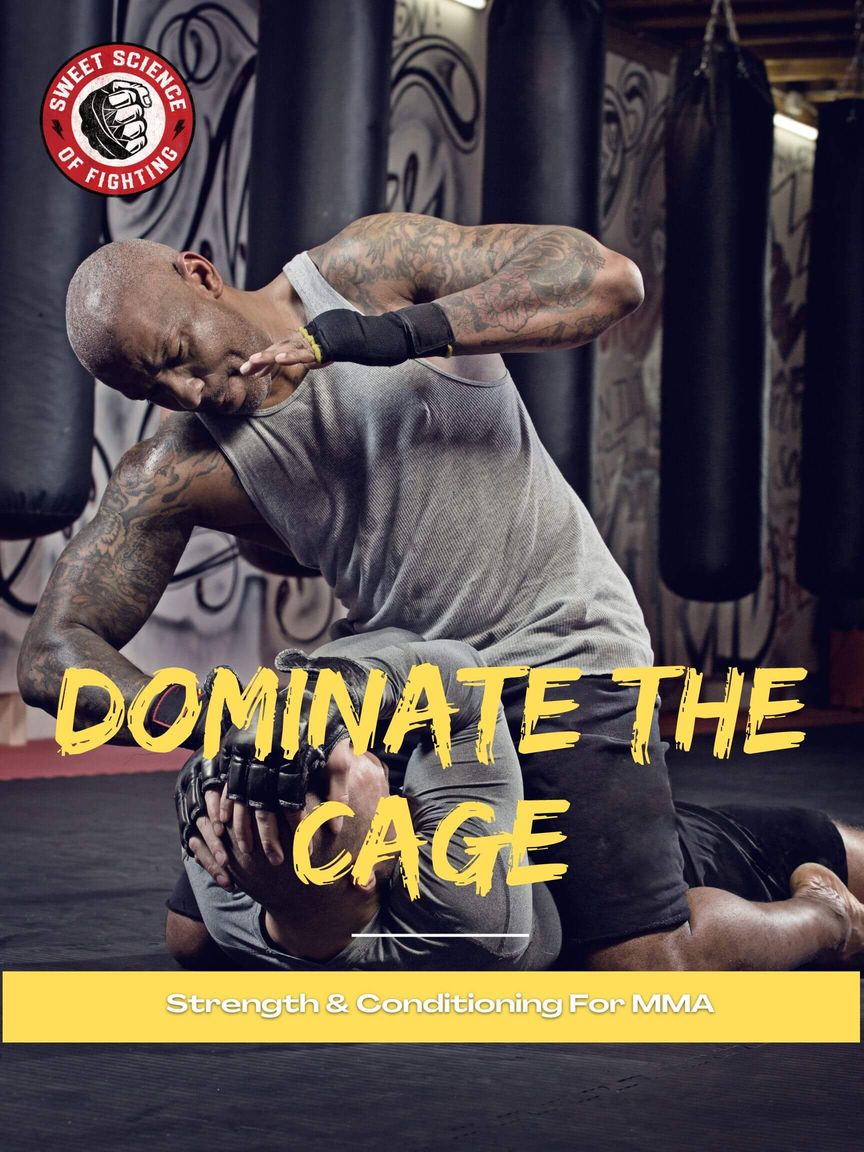MMA and karate are two different forms of combat that do not have much in common. But still, many people are interested to know which one is better and why. And in this article, we will take a closer look at MMA vs. Karate and what each martial art brings to the table.
MMA combines striking, grappling, and ground fighting techniques put into one combat system. Whereas Karate is a self-defense system that focuses on mixing hand and leg strikes together.
The emphasis of most karate styles is on light contact and beating the attacker with a high level of technique, speed, and precision. It has many styles and forms, of which some also include the basics of grappling and elbow and knee strikes.
On the other hand, MMA is the most versatile system often seen as the most effective for self-defense. Keep reading this article to learn more about MMA vs. Karate and how these two compare in different scenarios.
What Is Karate?
Karate is one of the most popular martial arts that is well spread worldwide. There are dozens of styles and forms that most focus on mixing hand and leg strikes. Some styles, notably traditional ones, also consist of elbow and knee strikes and the basics of grappling. Some of the most popular styles of karate are:
- Goju-Ryu
- Shotokan
- Kyokushin
- Shito-Ryu
Karate emerged in Japan in the 14th century in the Ryukyu Kingdom, a present-day island of Okinawa. At the time, people living on this island used to practice various martial arts, out of which most originated in China.
Later on, Japan annexed the Kingdom in 1879, which triggered the migration from the Ryukyu Islands to the main islands of Japan. Some of these people were skilled karatekas who started teaching karate upon arriving on the main islands at the start of the 20th century. Karate would soon become a prevalent martial art and a combat sport.
Although it is a versatile art, modern-day karate puts a lot of emphasis on competition and light contact. In some way, modern-day students spend more time learning how to compete instead of how to fight.

How to Dominate Every Fight with Raw, Explosive Power No One Can Match
Discover the underground blueprint that has quietly turned MMA hopefuls into legends, using nothing but sheer, brute force and bulletproof conditioning techniques.
What Is MMA?
MMA stands for “mixed martial arts.” It is a very popular combat sport where fighters use all limbs as weapons to fight in all places. They can strike on the feet, clinch, wrestle, and fight on the ground. To cover all the aspects and develop all-around skills, they must be experts in multiple martial arts like:
- Boxing (standup)
- Muay Thai (standup, clinch)
- Wrestling (grappling)
- BJJ (grappling, ground fighting)
The earliest origins of MMA go back to ancient Greece and the sport called “Pankration,” which resembles modern cage fighting. The modern form started to emerge in Japan with the famous “Shooto” promotion in 1986. But most MMA fans take the foundation of UFC in 1993 as the starting point of modern MMA.
MMA vs. Karate — What Is The Difference?
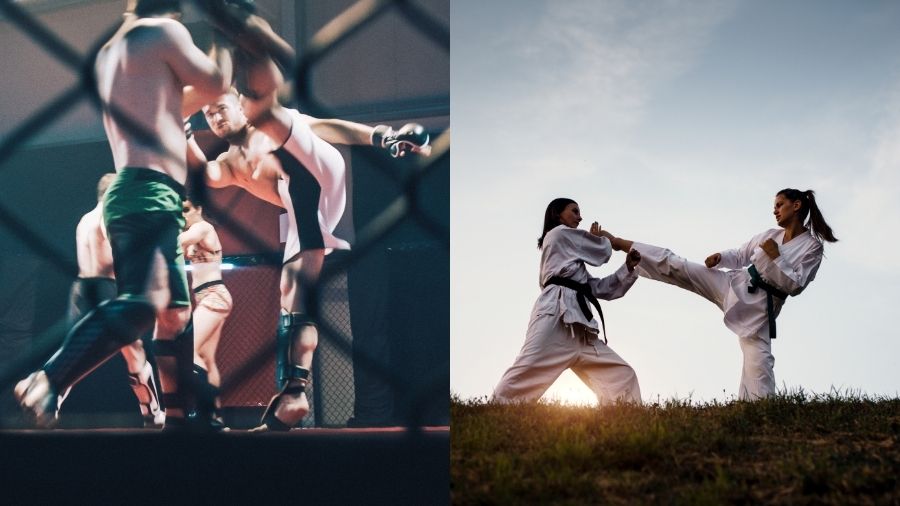
MMA and karate are two different forms of combat that do not share much else in common apart from a few striking techniques. These two are a world apart from rules, history, emphasis, methods of training, and many other aspects. Here is a brief look at all key differences that you should be aware of:
History And Origins
Karate is a martial art that has origins in Chinese martial arts. It emerged in the 14th century in the Ryukyu Kingdom, a present-day Okinawa Island in Japan. The term “karate” translates to “empty hand,” which explains that karate is a hand-to-hand self-defense system created for unarmed combat. Some of the earliest styles of karate were:
- Shorin-Ryu
- Goju-Ryu
MMA has origins in the ancient martial art called “Pankration.” The modern form began to emerge in Brazil in the 20th century with the rise of Vale Tudo, a very popular martial art tournament.
Vale Tudo was the first organization where fighters from different martial art could fight against each other under limited rules. Later on, the Japanese would create their first MMA promotion called “Shooto” in 1986, before the UFC came to the scene in 1993.
Emphasis And Strategies
The emphasis of karate varies between different styles. The majority of styles are semi-contact, emphasizing light contact, mixing hand and leg strikes, and beating the opponent without causing any serious injuries.
One style that differs a lot from the others is Kyokushin, which is full contact and where the main goal is to hurt or knock the opponent out cold. Karatekas rely on precision and clean striking, fast movement, footwork, and speed to win a fight.
Modern-day practice is all about competition, and students spend most of the time learning how to fight under the point fighting rules.
MMA is a combat sport where athletes fight in the standup, clinch, and grapple and fight on the ground. The main goal is to develop all-around skills to cover all the aspects of the sport. Each fighter must know how to strike using all limbs as weapons and mix striking with takedowns.
Once the fight hits the ground, they must know how to secure top control, ground and pound, or attack with chokes and joint locks. Being one-dimensional doesn’t work in modern MMA. To cover all aspects of MMA, a fighter must be an expert in at least two different martial arts.
Techniques
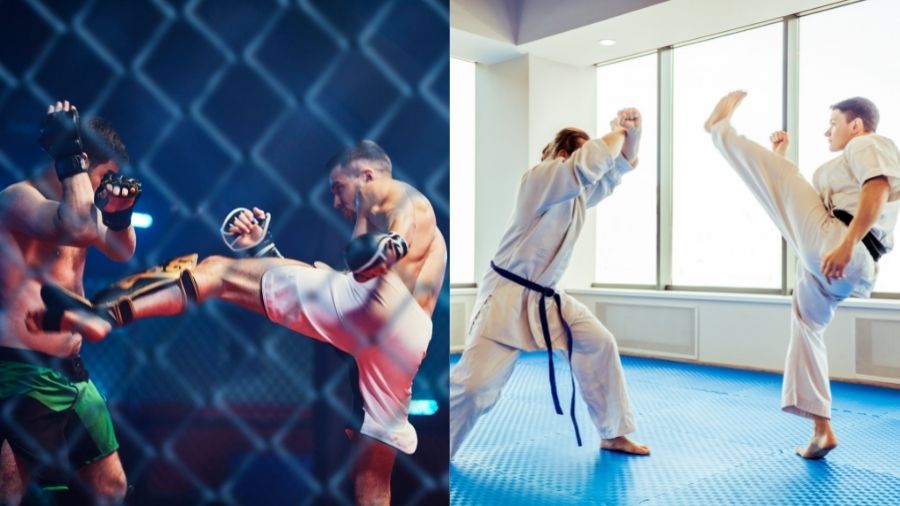
Karate is a martial art where fighters learn to use all limbs as weapons to strike. The exact number and type of techniques that students learn in training are based on a style of karate. But most modern karate schools emphasize hand and leg strikes and techniques like:
- Punches — (inverted punch, rising punch, hook, uppercut, jab, scissors punch, flat fist, open, etc.)
- Kicks (front kick, side kick, roundhouse kick, jumping kick, foot sweep, etc.)
- Elbow (forward elbow, downward elbow, back elbow, side elbow, forward elbow, etc.)
- Blocking techniques
- Dozens of different stances
MMA is the most versatile combat sport that consists of dozens of different grappling, ground fighting, and striking techniques. Most of the techniques that MMA fighters use come from four other martial arts:
- Boxing (footwork, upper body movement, blocks, punching combos)
- Muay Thai (advanced kicks, fighting in the clinch using elbows and knees)
- Wrestling (takedowns and top control on the ground)
- BJJ (positioning on the ground, joint locks, and chokes)
Rules
Karate rules vary between different styles and forms. For instance, some forms like Kyokushin are full contact, while some are semi-contact, and these styles also differ a lot when it comes to techniques you are allowed to use. For this article, let’s look at the Olympic rules of karate (Kumite):
There are three weight classes for men and three for women - Matches are semi-contact, and competitors cannot strike using full force.
- The matches last three minutes.
- The action resets after every successful point.
- Competitors can win a match by scoring eight points more than their opponent or having more points at the end of the match.
3 points (ippon) are awarded for hitting the head or neck with a kick. - 2 points (Waza-ari) for a kick to the torso, belly, or back.
- 1 point (Yuko) for landing a punch with a closed fist or other hand strikes to the head, neck, back, belly or torso.
MMA rules also vary between different organizations and promotions, but not that much. The most famous ruleset is the “Unified Rules of MMA” developed in the 2000s and used by prominent promotions like UFC and Bellator:
- Non-title matches are 3 rounds, with each round being 5 minutes long. Title fights are scheduled for 5 rounds.
- Fighters compete inside the steel cage in different shapes and sizes or a boxing ring.
- They wear a pair of open-fingered MMA gloves, MMA shorts, a groin cup, and a mouthguard.
- Each match includes three judges sitting beside and scoring the fight using a 10-point scoring system taken from boxing.
- Fighters can win a match by decision, knockout, submission, or disqualification.
Different Clothing
Karate is a traditional martial art where all students and instructors must wear a “karate Gi” uniform. This uniform is visually very similar to a judogi, but it is made of different materials. Gi is usually made out of smooth cotton. It weighs around 0.5kg, which is much lighter than judogi, approximately 1kg. Students also wear a color belt around their waist, representing their rank.
MMA students and competitors do not wear any uniforms. The only thing they wear on fight night is shorts, a groin cup, a mouth guard, and a pair of 4 OZ open-fingered gloves.
Strength & Conditioning
Karate strength training is mainly focused on developing upper and lower body explosive power without the need for greater muscle mass. Both MMA and karate have intense conditioning requirements. MMA has a work to rest ratio of 1:2 to 1:4 whereas karate Kumite has a work to rest ratio of 1:1 to 1:2.
MMA and karate have high aerobic energy system demands to sustain high-intensity efforts throughout a fight. As top MMA fighters display anaerobic power outputs greater than many wrestlers, MMA conditioning must maximize the development of all three energy systems.
Conditioning for karate on the other hand places greater emphasis on the alactic energy system due to 1:11 high-intensity effort to pause ratio during competitive matches.
MMA vs. Karate For Self-Defense

MMA is more practical than karate in most self-defense scenarios, and it should be your choice if you want to learn how to defend yourself. It is more versatile than karate, and its techniques and concept are far more effective in real fighting.
This may sound odd considering that karate is a self-defense martial art while MMA is a combat sport. But street fighting doesn’t recognize these differences. The only thing that matters is the effectiveness of the techniques and skills.
MMA is a combat system where students learn to fight both on the feet, in the clinch, and on the ground. It trains you for most scenarios you may face on the streets, and you would have a weapon to use no matter where the fight takes place.
Training is hard on your body, cardio intense, and includes a lot of sparring where you exchange strikes, roll on the ground, or mix it all together. Although this sounds like a lot of work, this is a price students need to pay to develop all-around skills and learn everything about the physical and mental aspects of fighting.
The best thing about MMA is that it consists of only the most effective techniques. Students don’t spend a second learning techniques that they can’t apply in real life.
Each segment of MMA is designed for real combat, and no matter what happens in a fight, you can rely upon your MMA skills to get out of trouble. The biggest and only downside is the lack of dirty tactics and weapon-based training, but this doesn’t make it less effective than karate.
On paper, karate is up there with MMA in a self-defense aspect. But in reality, most modern schools are oriented towards competition and teaching you how to fight under the point fighting rules.
These point fighting rules limit your fighting abilities and harm the overall effectiveness of karate. And on top of that, there is no full contact sparring in most styles of karate but rather a lot of katas, which is the main reason it is less effective than MMA.
Still, most techniques you learn are very practical, effective and are more than enough to deal with the attacker on the streets.
MMA vs. Karate — Which One Is Harder To Learn?
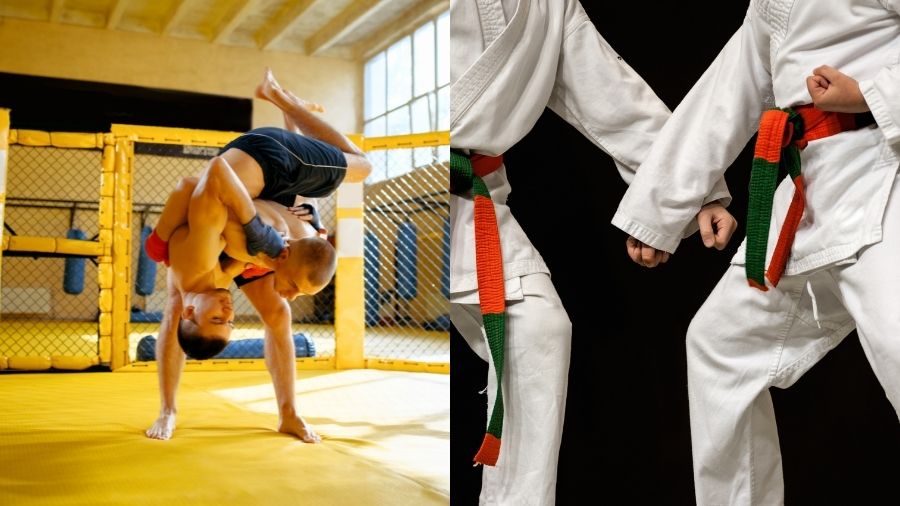
MMA is more challenging for most people and takes more time to master simply because it is more versatile than karate. There are many different techniques to learn, and it is physically more demanding. Of course, karate training is not a walk in the park either but is much easier to understand and is less physical than MMA.
The main goal in MMA is to learn how to mix grappling and striking together to fight at all places and ranges. Since not a single martial art covers all the elements of the sport, athletes need to be experts in at least two different martial arts.
For instance, a fighter with a strong base in wrestling must learn how to box, check kicks, and defend against joint locks and chokes.
So in a single week, MMA students have to practice striking, wrestling, and fighting on the ground. And like that is not enough work, they also need to work on their strength and conditioning.
All of this makes MMA hard on your body and mind and is why cage fighters are often seen as the finest athletes. On average, you need around 2-3 years to develop solid fighting skills and up to 10 years of training to reach a top level. There are no belt ranks or promotional criteria.
On the other hand, Karate training is not that hard to learn. The emphasis is on striking, and the techniques you learn are not that complex. It is much safer than MMA due to the lack of full contact, and there is far less sparring. On top of that, students never throw strikes using full power, which is the main reason why karate is so safe and popular among kids.
On average, students need from 3 to 5 years to reach a black belt in karate. The exact number of years truly depends on your talent and the style of karate.
Is Karate Good For MMA Fighting?
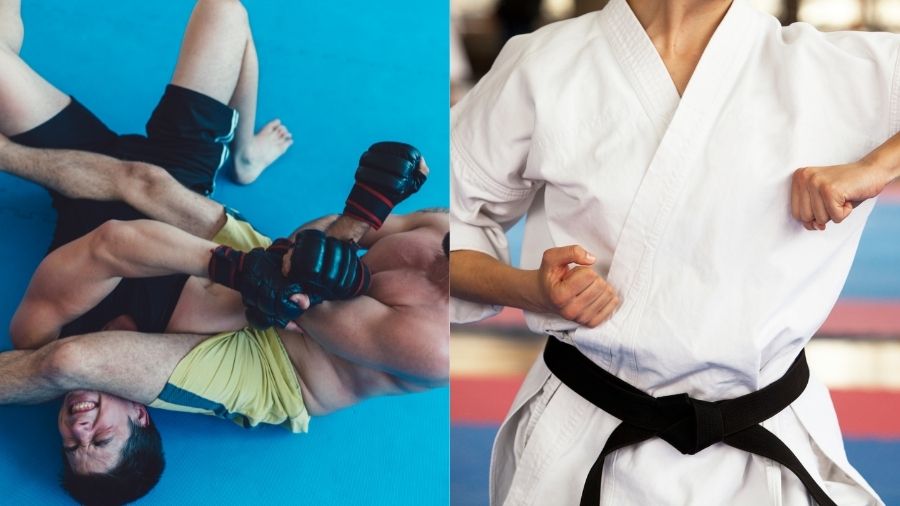
Karate is more than present in modern MMA. Not as much as some other martial arts, but you can often see fighters utilizing karate techniques in the UFC, for instance. Yet, bear in mind that being good at karate is not enough to succeed in MMA. You still need to learn how to grapple, fight on the ground, and develop many other skills to succeed in the game.
Karate matches well against other martial arts, and it fits well within the sport’s rules. What it brings to the table is unorthodox striking, quick movements, angles, and high precision. MMA fighters trained in karate are masters in moving in to land a strike and move out without being hit back.
This is mainly because of the point fighting rules where each successful strikes gets you a point and resets the action. That’s why karatekas are so quick on their feet, good at creating angles, and hard to hit.
They do best by picking the opponent apart from a distance with speed, technique, and precision. They also keep their range well, and it’s tough to cut their movement and connect with a clean strike. For instance, if you look at Stephen Thompson, most of his opponents have a hard time timing his attacks and landing counter shots.
But one of the main reasons they are a tough matchup for anyone is that it is hard to prepare for this style. In most MMA gyms, you can find a partner with a strong base in boxing, BJJ, or wrestling and train with them regularly. But on the other side, finding a sparring partner trained in karate might be challenging, especially while working your way up in the local gym.
Some of the most famous karate fighters in MMA are:
- Stephen Wonderboy Thompson
- Michael Venom Page
- Robert Whittaker
MMA vs. Karate — Which One Is Better For You?
Which one is better for you, karate and MMA, depends on your personal preference and what you want to achieve. The best way to make the right decision is to attend a trial class in both gyms and see which one fits your taste. Here is a final look at both arts that might help you make the right pick.
MMA is one of the most effective forms of combat that would teach you everything you need to know about fighting. It trains you to fight at all ranges and is by far the most versatile system. MMA is far more effective than karate, but it is much harder to train in, and it takes a lot of time to become a skillful fighter.
Karate is a martial art that puts a lot of emphasis on striking and competition. Training is much safer because there is no full contact sparring (except for Kyokushin). The entire concept and philosophy revolve around light contact.
Apart from fighting skills, training has many health benefits and is very popular among kids. In fact, you would rarely see people in their 20s joining a karate dojo. Adults are not heavy into traditional arts in modern times, wearing a gi uniform and doing katas. Instead, most of them choose to train in kickboxing, boxing, or MMA.
Biggest, Baddest Gas Tank In Just 8 Weeks
The Underground MMA Conditioning System specifically designed to develop elite level MMA cardio based on your easy to implement test results.
